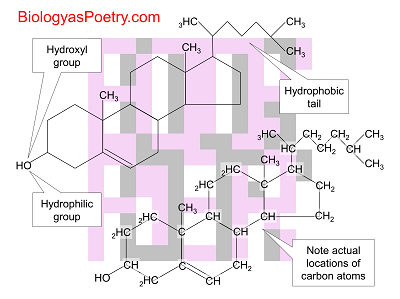∞ generated and posted on 2016.08.18 ∞
Multi-ringed, slightly hydrophilic lipid that is a common constituent of mammalian lipid bilayers.
Cholesterol serves as a temperature buffer of lipid bilayers, sterically interfering with phospholipid crystallization at lower temperatures and with phospholipid movement (fluidity) at higher temperatures. Membranes, as a result, are stable at fairly high temperatures but which can somewhat effectively resist freezing at lower temperatures.

Figure legend: Multi-ringed structure that is cholesterol, shown with carbons implicitly present (upper-left) and carbon atoms (as well as hydrogen atoms) explicitly shown (lower-right). Note the hydrophilic tail (to the left), which consists of a single hydroxyl (-OH) group. Note too the hydrophobic tail (to the right).
The chemical structure of cholesterol is very similar to that of steroid hormones.
The following video spends a good amount of time on LDLs and HDLs, but a good introduction; they kind of equate saturated fats and cholesterol towards the end, though, which is an over simplification:
The following video discusses the consequences of excess cholesterol in the body; note though that lipoproteins are not cells! (but instead extracellular multimolecular complexes):